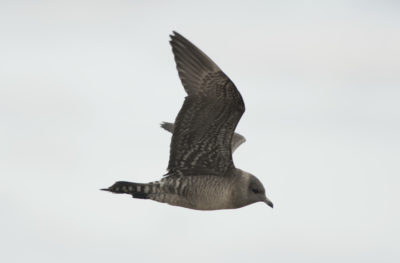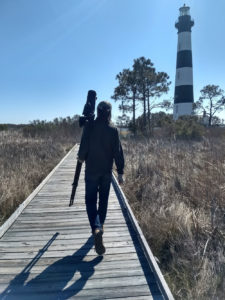Many words are used in desperate attempts to describe migration. Spectacle, miracle, phenomenon, and wonder are a few that come to mind. There’s a good reason for this desperation; though our knowledge of migration is far from comprehensive, every kernel we understand challenges our imagination. When looking at a songbird who has navigated thousands of miles through a myriad of hazards, it can be easy to lose the warranted appreciation. When rivers of waterbirds stream across the sky, this story is much harder to ignore.
As the fall seasonal waterbird counter, my responsibility is to contribute the year’s data set to a record kept since 1989. Through the work of dozens of observers, counters, and other contributors, we’re lucky to have a robust tally of the fall migration at Whitefish Point. Referencing this information, we can see trends emerge, and that’s one of the huge advantages to this census spanning the years it has. As was made evident by the shocking study showing that 3 billion birds have been lost since 1970, long-term monitoring initiatives are crucially important in influencing policy, opinion, science, culture, and awareness.
Though our final tally of 92,894 individual waterbirds was slightly above the count’s average of 87,807, it’s worth noting that this value is lower (8.6%) than the last decade’s average. These trends are nuanced as you pick apart how they are distributed to an order, family, and species. By and large, the number of ducks we recorded was lower than average. However, many dabbling ducks have shown particular trends that tell a different story. For instance, American Wigeon were recorded in slightly below-average numbers compared with the last decade but far above-average since the beginning of the count. This suggests that this population may have grown and stabilized since the count’s initiation. In the past several years, Blue-winged Teal had been observed in concerningly low numbers; yet, in this year’s count, they recorded in far above-average numbers. These stories play out differently from species to species, hinting at how unique these animals are despite our groupings.
It comes as no surprise that a majority of species were seen in lower numbers. There were 17 out of 25 Anseriformes (ducks, geese, swans, mergansers) below their averages. Some, such as Surf Scoter, were recorded in record low numbers far below the standard annual deviation. White-winged Scoter earned their third-lowest ranking in their history here. It is known that loons are facing declines across their range, reflected by our record low count of Common Loon. Bonaparte’s Gull also set a new recorded low, and several anticipated species were absent (such as Pacific Loon). These trends and changes are one of the reasons we do this survey. When we see growths and declines, we can start to question what fuels them and work toward meaningful action.

A Long-tailed Jaeger seen at WPBO in October 2020. Photo by Chris Neri
Diversity was record-breaking: 84 waterbird species were recorded, well over the average 73. A majority of this was from a well-rounded representation of expected waterbirds, though a few vagrant rarities added to this total. I’ll never forget scanning above the treetops during a slow migration day to see the distinctive silhouette of a frigatebird soaring along the bay-side shoreline. A Pied-billed Grebe greeted me on the pond one sunrise, the first fall record for this species. Arctic Tern, Marbled Godwit, Black-legged Kittiwake — all of these rare birds were notable, and the excitement they brought carried throughout the count. During an eight-hour day, a rare King Eider could take just a few seconds to dart across the horizon. After an hours-long spell of quiet, a flock of 200 Long-tailed Duck could come rolling into view. The presence of the unknown kept us sharp; if we looked away for just a moment, who knows what we could miss.
Including non-waterbirds, our count jumps to 103,216 individuals over 221 taxa (birds identified at the species and non-species level). Take a minute to think about that. Imagine that movement; it’s wildly humbling to witness. Like a fan on the sidelines of a marathon, I feel energized when I see these birds go by. I want them to make it. I’ll admit that I feel conflicted when I see an exhausted songbird bravely approach from Lake Superior, only to be swallowed whole by a resident Herring Gull. This is all part of a system much larger and complex than I can understand, I tell myself, though I feel some sadness for the deceased traveler. Watching falcons flaunt their aerial prowess as they catch migrating songbirds feels different. There’s a vulgarity to being swallowed whole by a bird who seems just at home eating discarded chips and an honor to being hunted by one of the most skilled aerial predators known.
At times we talk about migration as though it is an event. A singular happening that comes and goes year after year. Birds, and life, are always on the move. This fall’s birds, just as the generations before them, have passed by Whitefish Point in quantities that are challenging to imagine. This fall, I was honored to have a peek at one moment of migration, and it will stay with me forever.
~by Steve Backus, WPBO 2020 fall waterbird counter
This article appeared in the 2021 Winter Jack Pine Warbler. Featured photo: A mixed flock containing Bufflehead, Greater Scaup, and Long-tailed Duck at Whitefish Point Bird Observatory. Photo by Chris Neri

The complex and amazing stories found in nature have captured Steve for as long as he can remember. His particular passion for waterbirds found a home at Whitefish Point, and he hopes to contribute toward our understanding of their place in the world.
Whitefish Point Bird Observatory is a program of Michigan Audubon.
Located 11 miles north of Paradise, Whitefish Point Bird Observatory is the premier migration hot-spot in Michigan. Jutting out in Lake Superior, Whitefish Point acts as a natural migration corridor, bringing thousands of birds through this flyway every spring and fall. With its wooded dune and swale complex, distinctive to the Great Lakes region, the Point witnesses a huge diversity of migrants. Home to numerous rare breeding birds, this Globally Important Bird Area has recorded over 340 bird species. Research conducted at WPBO significantly contributes to an ongoing effort to increase knowledge of bird migration, encourage public awareness of birds and the environment, and further critical bird conservation.
There are two waterbird count seasons each year (April 15 – May 31 and August 15 – November 15). Learn more about WPBO waterbird count efforts here and follow the waterbird counter’s blog to stay up-to-date while they are hard at work. You can also follow along for live updates to the count through Dunkadoo.

